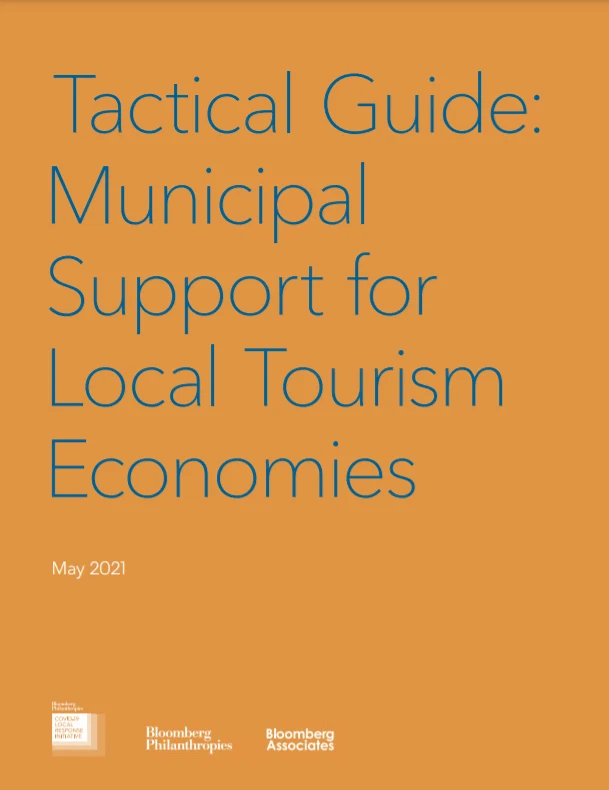COVID-19 Economic Response and Recovery
Provide Access to Funds and Resources for Tourism Businesses to Adapt
Action:
Provide access to finance and technical assistance to help small, tourism and hospitality businesses pivot, adapt, and capitalize on new demands and opportunities in a postpandemic world.
Why:
Keeping local, small businesses is critical for the recovery of your tourism economy. By helping them develop new online communications and sales channels, create new lines of business, or repurpose and adapt their space, you are helping to create longterm revenue solutions.
Background:
In 2020, U.S. travel spend declined by nearly $500 million and, while the industry improved between April and September, progress stalled in the final quarter of the year due to the continued absence of business travel and another surge in COVID-19 cases.
The travel economies of every city and state were affected. Seventy percent of U.S. metropolitan regions have at least 10% of their workforce in leisure and hospitality, and during 2020, cities in more than 18 states experienced 40+% downturn in travel spending. The impact was felt most by small businesses (with fewer than 500 employees), which make up 99.5% of the tourism sector and 60.6% of employment within the sector. Many of them face a time of extreme liquidity strain and most of them entered the pandemic with very limited cash flow.
Women and minorities have also been hard hit, with women- and minority-owned businesses comprising 63.5% of U.S. accommodation and food services businesses and 46.5% of arts and entertainment businesses.
Given that COVID-19 will probably be around for a long time, many tourism businesses will need to adapt and/or reinvent themselves for “the new normal.”
Case Study
Bellville Downtown District Marketplace
Belleville is a town located between Toronto and Ottawa in Canada. During Canada’s strict lockdown in 2020, the Downtown Belleville Improvement Area (a business improvement district) decided to embark on a project to create an online marketplace called the Downtown District Marketplace.
In just four weeks, the BID launched a website which allowed nearly two-dozen businesses to receive orders for curbside pickup. Today, the website hosts over a thousand products from local businesses, including restaurants, artisan markets, art associations, and galleries. It has attracted more than 50,000 visitors and over 1,000 orders. In fact, the marketplace has been such a success that the BID is no longer supporting it with grant funding.
The BID is currently developing the site to add shipping. Currently, customers can pick up curbside, or merchants manage deliveries themselves.
How the marketplace works
The BID created the marketplace on the Shopify platform. The platform charges the BID $299/month, plus $10/month for a multi vendor marketplace app, which means the BID does not become the merchant.
The BID was fortunate to have two young staff members with the technical skills needed to design a website. They created pages for each local business, which only they could access and edit.
Shopify collects the money from the sales, and the BID pays its merchants every 2 weeks. Each local business is responsible for paying credit card and transaction fees. The BID doesn’t take any commission. The local businesses greatest concern about the marketplace was payment terms. Early on in the project, the BID spent many hours sorting out payments to the local businesses, but it has since managed to automate this process.
Launching the marketplace
The BID launched the marketplace with a teaser campaign, which included VIP access to the first 250 people that signed up for its newsletter. In this way, it was able to gather feedback on issues that early users faced and make adjustments before opening to the general public.
Its subsequent marketing tactics have included social media (paid and organic), digital advertisements, local radio, and press releases sent to local and national media outlets. Local partners have also provided content and written features for the Marketplace.
The BID did not receive support from the city to launch the Marketplace. It did, however, receive funding from a regional marketing board to run a contest on the website — users who spent $50 could win Marketplace gift cards to use on their
next purchase.

How To Adopt This Approach:
The project’s success was based on strong relationships with local businesses
1. Assemble and train a group of 5–10 local business owners, who will become
your ambassadors to get other merchants on board
2. Regularly engage business owners and provide sufficient training about the sales platform, recognizing that different business owners have different levels of digital literacy. This will mean creating step-by-step guides, complete with screenshots on how to add products and make payments
3. Help merchants to become confident selling online. Just as a shop needs an attractive window display, a website needs beautiful photos. Merchants will also have to do their own marketing to drive traffic from their website to the Marketplace, for example, by posting and buying advertisements on social media.

Do:
- Do spend time building the trust and confidence of your member businesses.
- Do regularly engage with your business owners and provide support based on their differing levels of digital literacy.
- Do set aside considerable time at the beginning to sort out payments from Shopify to vendors.
Don’t:
- Don’t assume any knowledge. Create stepby- step guides, and share information on how businesses can take good photographs, buy ads, and market their businesses on social media.
